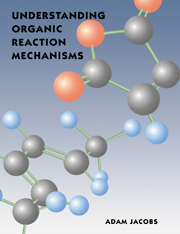Book contents
4 - Reactive carbon species
Published online by Cambridge University Press: 05 June 2012
Summary
In any organic reaction, carbon plays a part. Although, as we shall see in Chapter 5, atoms other than carbon can have profound effects on the reactivity of organic molecules, reactions taking place at carbon atoms themselves are of great importance. In this chapter we shall look at reactive intermediates based on carbon. We shall see what types of intermediates carbon can form, and we shall look at the factors affecting their stability and at their common patterns of reactivity.
Carbanions
Structure and stability of carbanions
Firstly, we should be clear about what we mean by the term ‘carbanion’. A carbanion is a molecule in which a negative charge resides on a carbon atom. This sounds like a straightforward definition, but in practice two factors can complicate it.
The first of these is that any anion must exist with a positive counter-ion; for carbanions this is almost always a metal ion. The complication here is that the carbanion and its counter-ion might not be independent of each other, but instead have a degree of covalent bonding (Figure 4.1). Although this covalent bonding may be negligible, as in the potassium salt of the triphenylmethyl anion, it can sometimes be particularly pronounced, as in organomercury compounds. Grignard reagents (organomagnesium compounds) are a common type of carbanion-like molecule in which the carbon–metal bond has significant covalent character.
This is not the place for a detailed discussion of the complex subject of bonding in organometallic compounds, and in this chapter we will refer to many compounds as carbanions, even if there is significant covalent bonding between the carbon and the metal.
- Type
- Chapter
- Information
- Understanding Organic Reaction Mechanisms , pp. 84 - 114Publisher: Cambridge University PressPrint publication year: 1997

